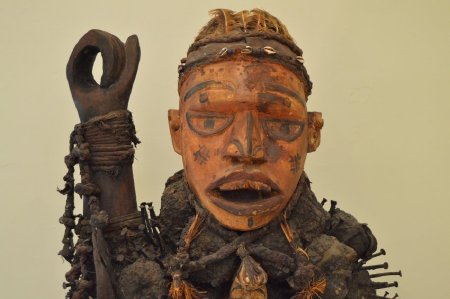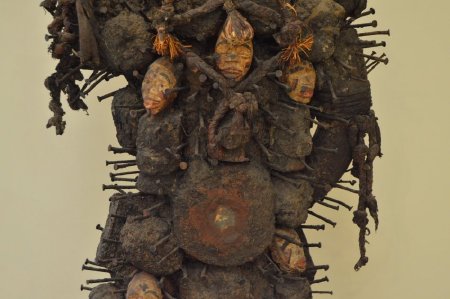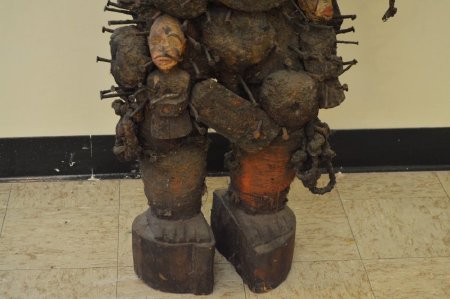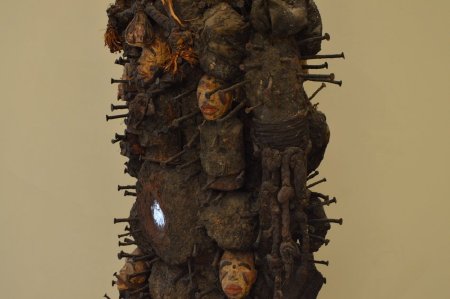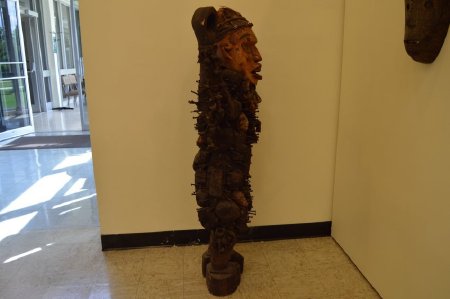Title:
Congo Nkisi Nkondi Fetish Figure
Object Name:
Figure, Fetish, Kongo, Nkisi
Other Name:
Figure, Fetish, Nail, Nkondi
Place of Origin:
Kongo, Democratic Republic of Congo, Africa
Provenance:
Aboriginal Indigenous Art.
H = 53"
W = 25"
D = 15"
The Kongo peoples use Nkissi Nkondi figures to bind oaths, seal contracts, or finalize treaties. To complete an agreement, packets containing bilongo power substances, such as earth from a tomb, river mud, and powered camwood, are attached to the figure with twine. Nails and pieces of metal are driven into the figure to activate its spirit. If the oath is broken, it is belived that the spirit embodied in the ferocious looking figure will punish the transgressor with a spear, originally held in the hole in the figure's right hand.
In order to stimulate and obtain a spirit's protection, Kongo people hammer nails into its wooden representation, shout at it, and sometimes insult it.
Bacquart, P. 128 — 131.
Nail and mirror fetishes are a unique and important phenomenon of Kongo sculpture. In the Kongo, all these fetishes are called nkisi. Nkisi means “medicine”. Historically, there were two types of nkisi, public and private, with some having vital democratizing roles, as sources of empowerment for rural residents and individuals outside the court. At most basic, the nkisi represents a container of empowering materials or “medicines” called bilongo. The magical substances may be blood along with animal, vegetable, and mineral matter. They are believed to invest the fetish figure with power and make it possible for the devotee to establish contact with the spirit. The “medicines” are generally secured in cavities in the stomach, head, or back to activate the work with the empowering agent. The nkisi, properly endowed with magic substances and additions by the nganga or doctor, had the power to act in a number of ways. There are four main types of nkisi, used for different purposes. Nkondi are fetishes of ill omen, usually brandishing a spear or a knife, while npezo are just as evil, but less menacing in attitude. Na moganga are benevolent figures, which protect against sickness and dangerous spirits. They help the hunter and the warrior; while mbula protect against witchcraft. All nkisi can be used for a variety of purposes and their meaning is ambivalent. The fetishes also may represent animals: two—headed dog, sometimes monkey.
H = 53"
W = 25"
D = 15"
The Kongo peoples use Nkissi Nkondi figures to bind oaths, seal contracts, or finalize treaties. To complete an agreement, packets containing bilongo power substances, such as earth from a tomb, river mud, and powered camwood, are attached to the figure with twine. Nails and pieces of metal are driven into the figure to activate its spirit. If the oath is broken, it is belived that the spirit embodied in the ferocious looking figure will punish the transgressor with a spear, originally held in the hole in the figure's right hand.
In order to stimulate and obtain a spirit's protection, Kongo people hammer nails into its wooden representation, shout at it, and sometimes insult it.
Bacquart, P. 128 — 131.
Nail and mirror fetishes are a unique and important phenomenon of Kongo sculpture. In the Kongo, all these fetishes are called nkisi. Nkisi means “medicine”. Historically, there were two types of nkisi, public and private, with some having vital democratizing roles, as sources of empowerment for rural residents and individuals outside the court. At most basic, the nkisi represents a container of empowering materials or “medicines” called bilongo. The magical substances may be blood along with animal, vegetable, and mineral matter. They are believed to invest the fetish figure with power and make it possible for the devotee to establish contact with the spirit. The “medicines” are generally secured in cavities in the stomach, head, or back to activate the work with the empowering agent. The nkisi, properly endowed with magic substances and additions by the nganga or doctor, had the power to act in a number of ways. There are four main types of nkisi, used for different purposes. Nkondi are fetishes of ill omen, usually brandishing a spear or a knife, while npezo are just as evil, but less menacing in attitude. Na moganga are benevolent figures, which protect against sickness and dangerous spirits. They help the hunter and the warrior; while mbula protect against witchcraft. All nkisi can be used for a variety of purposes and their meaning is ambivalent. The fetishes also may represent animals: two—headed dog, sometimes monkey.
Description:
Standing wooden figure with large head, wearing a cloth, feather and cowrie shell hat. Broad short nose, large mouth with open lips, showing top row of teeth. Oval—shaped ears, no visible neck. Round pads of medicine adhered to wooden body by rusty nails, other rusty nails stuck into body around neck, chest and legs. Upraised right hand beside head, with open fist, with missing spear. Left hand carved along side of body, rectangular medicine pouch with glass front on stomach, surrounded by brown cloth balls of medicine. Short legs wrapped in cloth, crescent—shaped wooden feet, dark brown patina and libation over majority of surface area.
Collection:
Guy Mace Collection, (Turblex Company)
Material:
Wood W/Metal, Cloth, Glass and Fetish Material
Used:
Ritually Used
Technique:
Carving / Painting / Weaving
Owned:
Art Department, Missouri Southern State University
Accession#:
2015.2.13

